Chapter 17: Financial ratios
Chapter learning objectives
Upon completion of this chapter you will be able to:
- calculate return on capital employed (ROCE) with data provided
- explain the meaning and usefulness of a calculated ROCE figure
- calculate earnings per share (EPS) and price earnings (PE) ratio with data provided
- explain the meaning and usefulness of an EPS figure and a PE ratio
- calculate return on equity (ROE) with data provided
- explain the meaning and usefulness of a calculated ROE figure
- calculate dividend per share (DPS) with data provided
- explain the meaning and usefulness of a DPS figure
- calculate dividend yield with data provided
- explain the meaning and usefulness of a dividend yield figure
- calculate total shareholder return (TSR) (dividend yield plus capital growth) with data provided
- explain the meaning and usefulness of a TSR (dividend yield plus capital growth) figure
- select appropriate ratios to measure changes in shareholder wealth within a scenario and discuss the relevance of the findings.
- define, calculate and explain the significance to a company's financial position and financial risk of its level of the following ratios:
- operating gearing
- financial gearing
- interest cover
- interest yield
- dividend cover
- dividend per share
- dividend yield
- earnings per share (EPS)
- price/earnings (PE) ratio
- assess a company's financial position and financial risk in a scenario by calculating and assessing appropriate ratios

1 The importance of financial ratios
 Ratio analysis is the process of comparing and quantifyingrelationships between financial variables, such as those variables foundin the statement of financial position and income statement of acompany.
Ratio analysis is the process of comparing and quantifyingrelationships between financial variables, such as those variables foundin the statement of financial position and income statement of acompany.
 The ability to carry out effective ratio analysis and to be able tointerpret the meaning of ratios is fundamental to the F9 syllabus.
The ability to carry out effective ratio analysis and to be able tointerpret the meaning of ratios is fundamental to the F9 syllabus.
Financial ratios and ratio analysis are key aspects within all of the following syllabus areas:
- Measuring the achievement of corporate objectives
- Investment appraisal
- Working capital management
- Capital structure
- Business valuations

 Financial ratios and the different syllabus areas
Financial ratios and the different syllabus areas
Measuring the achievement of corporate objectives
For a company, the primary objective has been identified as themaximisation of shareholder wealth. However, in the short-term themanagement may set profitability targets (either as interim goals orbecause they better represent the concerns of the managers).
Managers will need to review financial ratios to identify whether targets are being met and to help with decision making.
Investment appraisal
We've seen that one way in which investments can be appraised is tolook at the return on capital employed (ROCE). This is a widely usedfinancial ratio.
In addition to this, managers may need to consider the impact that anew investment may have on the financial ratios of the organisationbefore deciding whether to invest or not.
Working capital management
We've seen that to assess the length of the cash operating cycle, anumber of financial ratios must be calculated and then compared againsta benchmark. Again, these ratios are vital for managers to be able totake informed decisions.
Capital structure
Gearing ratios can be a crucial way in which potential investorsassess the risk of a business, which in turn will influence theirdecision over whether to invest or not. Before taking decisionsregarding sources of finance, the financial manager must assess theimpact of each option on these ratios.
Business valuations
Any potential equity investor or purchaser will review thefinancial ratios of a business before deciding whether to buy. They willuse the ratios to draw conclusions about the worth of the business.

 Taken in isolation, the calculations are relatively meaningless.Comparatives such as prior-year information, targets, industry averagesand other forms of benchmarking are required if the measures are to beinterpreted and the underlying causes investigated.
Taken in isolation, the calculations are relatively meaningless.Comparatives such as prior-year information, targets, industry averagesand other forms of benchmarking are required if the measures are to beinterpreted and the underlying causes investigated.
All the ratios calculated in the chapter are based upon the following information:
Statements of financial position as at 31 May


Income statements for the year ended 31 May
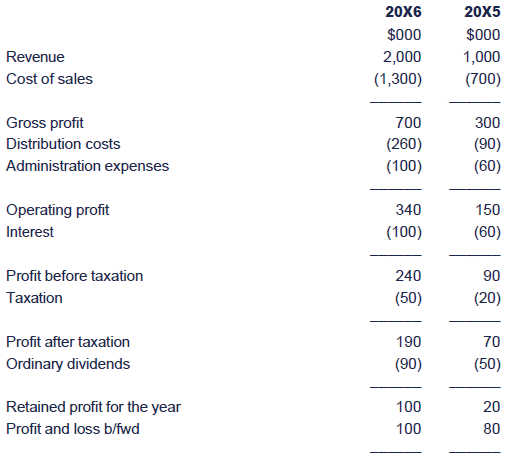
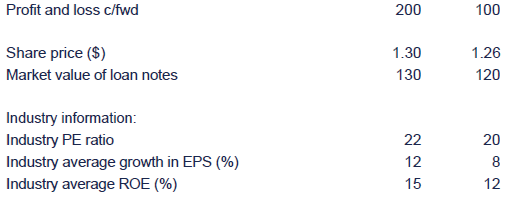
2 Categories of ratios
The key ratios that you need to be able to calculate and interpret can be broken down into four broad categories:
- Profitability and return
- Debt and gearing
- Liquidity
- Investor ratios
3 Profitability and return
Profitability and return ratios are probably the most widely used.They are key to any financial manager wanting to assess performanceagainst objectives as well as being crucial to the investment decision.
An external investor will also monitor these ratios closely whendeciding whether to provide the company with finance and to assess thevalue of the overall business.
Return on Capital Employed (ROCE)
 Considered to be a key ratio, ROCE gives a measure of how efficiently abusiness is using the funds available. It measures how much is earnedper $1 invested.
Considered to be a key ratio, ROCE gives a measure of how efficiently abusiness is using the funds available. It measures how much is earnedper $1 invested.



Disadvantage of ROCE:
- uses profit, which is not directly linked to the objective of maximising shareholder wealth.

 Illustration 1 – ROCE
Illustration 1 – ROCE
ROCE
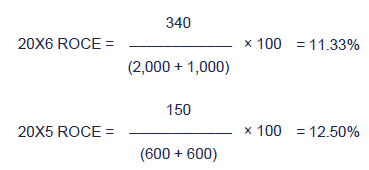
The company's ROCE has decreased in 20X6, i.e. for every $100 ofcapital invested the company earned $11.33 in 20X6 compared with $12.50in 20X5.


 ROCE
ROCE
When assessing company performance, return on capital employed (ROCE) is often broken down as follows:


Return on Equity (ROE)
ROE measures how much profit a company generates for its ordinary shareholders with the money they have invested in the company.
It is useful for comparing the profitability of a company with other firms in the same industry.
It is calculated as


ROE is similar to ROCE except:
- PAT is used instead of operating profit
- Shareholders' funds are used instead of CE (debt + equity).
Disadvantages of ROE:
- it uses profits which are an unreliable measure and not directly linked to shareholder wealth
- it is sensitive to gearing levels – ROE will increase as gearing ratio increases.

 ROE
ROE
The value of ROE, is that it can help cut through the references to'achieving record earnings' in many companies' annual reports.Achieving higher earnings each year is straightforward because asuccessful company generates profits every year. If management simplyinvested those earnings in a savings account paying 5% pa, they would beable to report 'record earnings' because of the interest they earned.But the shareholders would not be as well off as if the money had beenreturned to them for re-investment in another business opportunity.
So investors cannot take rising earnings per share each year as asign of success. However the ROE figure takes into account the retainedearnings from previous years, and so tells investors how effectivelytheir capital is being reinvested. It is therefore a far better measureof management's abilities than the annual EPS.
However, apart from the obvious criticism that ROE still relies onthe profit figure calculated, it is also sensitive to gearing levels.Assuming that the proceeds of debt finance can be re-invested at areturn greater than the borrowing rate, then the greater the levels ofdebt in the capital structure, the higher the ROE will be.


 Illustration 2 – ROE
Illustration 2 – ROE

The ROE is falling. What is more, it is falling at a time when theindustry average has risen from 12% to 15%. This suggests that thecompany is failing to make the most of the shareholders' investment.This analysis accords with the findings of the ROCE and the PE ratio.

Profit margins
Depending on the format of the income statement, you may be able tocalculate the gross profit margin and operating profit margin asfollows:
A comparison of the changes in the two ratios can often reveal more information about cost control and the changes inoperating gearing.

 Illustration 3 – Profit margins
Illustration 3 – Profit margins
Gross profit margin

Operating profit margin

The 5% increase in gross profit margin is good news for thebusiness as it indicates a wider gap between selling price and cost ofsales.
However, the operating margin has only increased by 2% indicatingthat expenses (distribution and administration) have increased and mayrequire tighter control.

4 Debt and gearing
Ratios that look at debt and gearing are a crucial way of assessing the risk profile of the business.
They will therefore be used extensively by financial managers whentaking financing decisions as well as by current and potential investorswhen assessing the amount of financing to offer and the level of returnto demand.
The basic calculations of operating gearing and financial gearing have already been covered in the previous chapter.
Further ratios to be aware of are detailed below.
Interest cover
Interest on loan stock (debenture stock) must be paid whether or not the company makes a profit.
 Interest cover is a measure of the adequacy of a company's profits relative to its interest payments on its debt:
Interest cover is a measure of the adequacy of a company's profits relative to its interest payments on its debt:
The lower the interest cover, the greater the risk that profit(before interest and tax) will become insufficient to cover interestpayments.
In general, a high level of interest cover is 'good' but may alsobe interpreted as a company failing to exploit gearing opportunities tofund projects at a lower cost than from equity finance.
Note: the interest cover ratio is the inverse of the interest gearing ratio.

 Illustration 4 – Interest cover
Illustration 4 – Interest cover
Interest cover

The company is in a strong position as regards the payment ofinterest. Profit would have to drop considerably before any problem ofpaying interest arose.

5 Liquidity
All of the liquidity ratios were covered in the chapter on working capital management.
6 Investor ratios
An investor is interested in:
- the income earned by the company for him
- the return on his investment.
For an ordinary shareholder the relevant information will be contained in the following ratios:

In general, the higher each of these ratios is, the more attractivethe shares will be to potential investors, who will be increasinglyconfident about the return the shares will give.
Shareholders will also want information on the total shareholder return (TSR).
For a debt investor, they will be interested in the interest yield ratio.
Earnings per share (EPS)
 This is the basic measure of a company's performance from an ordinaryshareholder's point of view. It is the amount of profit, in cents,attributable to each ordinary share.
This is the basic measure of a company's performance from an ordinaryshareholder's point of view. It is the amount of profit, in cents,attributable to each ordinary share.
The principles of calculating EPS are simple:


EPS can be analysed by studying the growth rate over time – trend analysis.Disadvantage of EPS.
- EPS does not represent actual income of the shareholder and it uses earnings which are not directly linked to the objective of maximising shareholder wealth.

 Illustration 5 – EPS
Illustration 5 – EPS
Solution
The EPS is an improvement on the prior year. It has grown by:

This is slightly higher than the industry average (12%).


 EPS
EPS
Although the ratio is simple in principle, in practice there may be a number of complications as both the definitions of earnings and shares in issuerequire careful analysis. Accounting treatment may cause the ratios tobe distorted, if for example the earnings figure includes the effects ofextraordinary items.
When calculating the EPS you cannot compare EPS of one company withEPS of another, as the answer would be meaningless. You should firstcalculate the growth rate of the EPS and then compare it with the growthof similar companies.
EPS does not represent the income of the shareholder. Rather, itrepresents the investor's share of profit after tax generated by thecompany according to an accounting formula. Whilst there is obviously acorrelation between earnings applicable to individual shareholders andtheir wealth, they are not equal.

Price Earnings (PE) ratio
A PE ratio gives a basic measure of company performance. Itexpresses the amount the shareholders are prepared to pay for the shareas a multiple of current earnings.
 A high PE ratio indicates that investors perceive the firm's earningsto be of high quality – usually a mixture of high growth and/or lowerrisk expectations.
A high PE ratio indicates that investors perceive the firm's earningsto be of high quality – usually a mixture of high growth and/or lowerrisk expectations.

 PE ratio
PE ratio
This is the basic measure of a company's performance from themarket's point of view. Investors estimate a share's value as the amountthey are willing to pay for each unit of earnings. It expresses thecurrent share price as a multiple of the most recent EPS.
If a PE ratio is high, investors expect profits to rise. This doesnot necessarily mean that all companies on high PE ratios are expectedto perform to a high standard, merely that they are expected to dosignificantly better than in the past. They may have greater growthpotential because they are coming from a low base.


 Illustration 6 – PE Ratio
Illustration 6 – PE Ratio

Investors are willing to buy shares in the company at 16.4 timeslast year's earnings compared with the previous year's position whenthey were willing to pay 18 times the earnings.
This fall may be because the company is not expected to grow asmuch as in the previous year. The industry average PE increasedyear-on-year from 20 to 22, which may suggest that this company isexpected to generate slower growth or carries more risk than theindustry average.

Dividend per share (DPS)
The DPS helps individual (ordinary) shareholders see how much of the overall dividend payout they are entitled to.


The DPS is usually given in the company's financial statements.
 Illustration 7 – DPS
Illustration 7 – DPS

The DPS is falling. This would usually be regarded as bad news byinvestors, although here it is probably related to the share issue in20X6. If it was a rights issue, e.g. the shareholders will now each own agreater number of shares.


 DPS
DPS
Since the shareholders are the owners of the business, they areentitled to their share of the profits. This is most simply achieved bypaying the amount out as a dividend. It is usually expressed as anamount per share. This is because the total amount a shareholder getshas to reflect their share of the company. If they are only a smallshareholder and do not own many shares, they should only get a smallshare of the profit.
There is a tendency amongst investors to regard the level ofdividend payout as a form of information about the company'sperformance. A falling DPS is regarded as a sign of problems. As aresult many companies try to maintain a stable and slowly rising DPS, byresisting making high payouts during particularly good years.

Dividend cover
 This is calculated as:
This is calculated as:
It is a measure of how many times the company's earnings could pay the dividend.
The higher the cover, the better the ability to maintain dividends,if profits drop. This needs to be looked at in the context of howstable a company's earnings are: a low level of dividend cover might beacceptable in a company with very stable profits, but the same level ofcover in a company with volatile profits would indicate that dividendsare at risk.
Because buyers of high-yield shares tend to want a stable income, dividend cover is an important number for income investors.

 Illustration 8 – Dividend cover
Illustration 8 – Dividend cover

The profits available for ordinary shareholders are taken afterdeduction of the preference dividend. The cover represents the'security' for the ordinary dividend – in this company the cover isreasonable.

Dividend yield
This provides a direct measure of the wealth received by the(ordinary) shareholder. It is the annual dividend per share expressed asan annual rate of return on the share price.


It can be used to compare the return with that from a fixed-rate investment.Disadvantage of dividend yield:
- it fails to take account of any anticipated capital growth so does not represent the total return to the investor.

 Illustration 9 – Dividend yield
Illustration 9 – Dividend yield

This return may compare unfavourably with interest rates but is nota full measure of company performance as the investor will also benefitfrom any increase in share price. As stated before, the low DPS maywell be, in part, because of the recent share issue and this will alsoclearly impact the dividend yield.


 Dividend yield
Dividend yield
The dividend yield is regarded as being significant in the contextof reaching decisions about whether to buy or sell shares. Investors areconcerned with the amount of cash, in present value terms, which theywill receive from their investment in shares. This cash is the resultof:
- dividends received
- proceeds when the shares are ultimately sold.
No ratio provides full information about future cash flows but dividend yield is regarded as being a useful pointer.
Dividend yield is, however, incomplete in that it ignores thecapital gain on the share which most shareholders would expect. A bettermeasure would be total shareholder return (TSR).

Total shareholder return (TSR)
This measures the returns to the investor by taking account of:
- dividend income
- capital growth.


TSR makes comparing returns between investments simple, irrespective of the size of the underlying investment.
 Illustration 10 – TSR
Illustration 10 – TSR
If we assume that the share price was $1.20 at 31 May 20X4, then the TSR for the two years can be calculated:



 TSR
TSR
Probably the best measure of returns to equity, TSR takes accountof the dividend income paid to shareholders and the capital growth ofthe share.
The TSR from an investment can easily be compared between companiesor benchmarked against industry or market returns without having toworry about differences in size of the business.
The actual return received by the investor will depend on theshareholder's marginal rate of income tax and the capital gains taxsuffered on any realised capital gain. Whether the shareholders preferhigh dividend income or high capital gains will therefore depend verymuch on their tax position.
The TSR can also be calculated as the dividend yield (based on the opening share price) plus the capital gain over the year.

Interest yield
 The interest yield is the interest or coupon rate expressed as a percentage of the market price:
The interest yield is the interest or coupon rate expressed as a percentage of the market price:
It is a measure of return on investment for the debt holder.

 Illustration 11 – Interest yield
Illustration 11 – Interest yield

Note: This can be calculated based on one "block" of debt(nominal value = $100) or can be calculated using the total interestpayment and the total market value.
The reason for the decline in the interest yield is nothing to dowith the company. Instead it reflects a movement in interest rates inthe market (and in particular the risk free rate).
Debt investors will still be interested in the level of interestyield as it will help them to assess whether the level of return issufficiently above the risk free rate to compensate them for the riskassociated with the investment.

 Beingable to select relevant ratios in a given scenario, calculate andinterpret them is a key skill that you need to develop for theexamination.
Beingable to select relevant ratios in a given scenario, calculate andinterpret them is a key skill that you need to develop for theexamination.
7 Combining ratios
When presented with information on some ratios, it is sometimespossible to combine two or more ratios in order to reveal another. Forexample:

So, when tackling a question in the exam, if you feel like you'remissing a vital piece of information, consider what ratios you have beengiven, and the elements that go in to each, and this may reveal a wayforward.

 Test your understanding 1 – Financial ratio analysis
Test your understanding 1 – Financial ratio analysis
Summarised statement of financial position at 31 December 20X6


Summarised income statement for the year ended
31 December 20X6
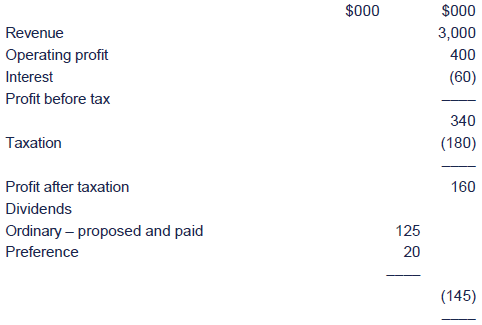

Using the information above, calculate thefollowing ratios and comment on your findings:
(a)ROCE – prior year 11%
(b)EPS – prior year 13.5c, industry average growth 3.5%
(c)PE ratio – industry average 7
(d)ROE – prior year 7%, industry average 7.5%
(e)DPS – prior year 12.5c
(f) Dividend yield
(g)TSR – prior year 20%, industry average 19%.

Chapter summary
Test your understanding answers

 Test your understanding 1 – Financial ratio analysis
Test your understanding 1 – Financial ratio analysis
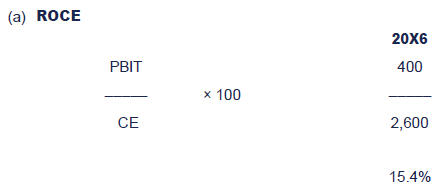
This short-term measure has improved suggesting the company is improving the efficient use of its funds.
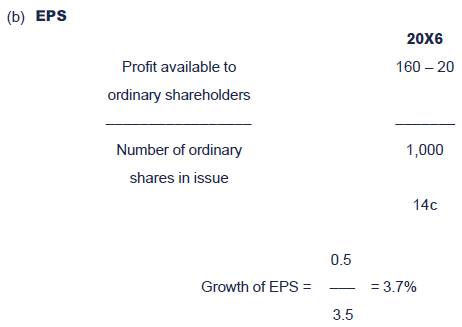
The EPS is growing at a rate marginally above the industry average,which suggests an acceptable level of profitability is being achieved.

The PE ratio is higher than the industry average. This may bebecause the company is perceived to have good growth prospects. It islikely to be seen as having good investment potential since investorsare prepared to pay ten times over the current earnings for the shares.
The current growth in EPS is fairly low but the company may be expected to make great improvements in the coming years.
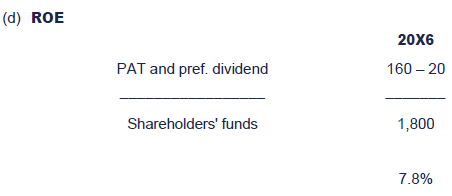
The ROE is higher than last year. So in addition to the rising EPSit appears that the company is re-investing the funds it earnseffectively. It also appears to be doing better than the industry as awhole. It would be useful to know what the industry average figure wasin the previous year in order to determine the trend in its performance.
This finding is in line with the high PE ratio – if the firm isre-investing the funds it earns effectively it will be perceived aslikely to develop good growth opportunities.
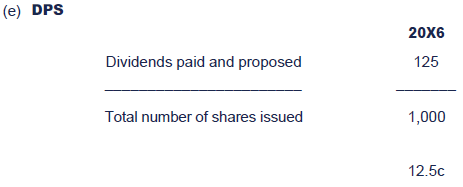
The DPS is unchanged despite an increase in EPS. This would makesense, as management are often reluctant to increase dividends tooquickly, in case poor trading conditions in future years would thenrequire a dividend cut. Dividend cuts are not well liked by investors.
Since the high PE ratio suggests good growth prospects, management may delay a dividend increase until these come to fruition.
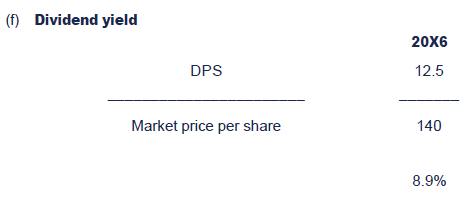
Prior year dividend yield can be calculated as prior year DPS divided by previous share price:
It is inevitable that the dividend yield is falling, since thedividend has not been increased whilst the share price has grown. Thisshows the weakness of dividend yield as a measure – the shareholdersare also benefiting from the increased share price but dividend yielddoes not take account of it.
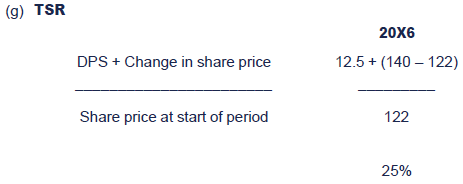
The overall TSR is above industry average and increasing (prioryear = 20%). This can be explained by the increase in share price whichsupplements the dividends received. This increase is a sign of increasedinvestor expectations of future income.
Overall, this appears to be an efficient growing company withpromising prospects recognised by shareholders. Managers are prudentlydelaying increasing dividend payments too early, to avoid later dropsfuelling investor dissatisfaction and a resulting fall in share price.

|
Created at 5/24/2012 4:20 PM by System Account
(GMT) Greenwich Mean Time : Dublin, Edinburgh, Lisbon, London
|
Last modified at 5/25/2012 12:54 PM by System Account
(GMT) Greenwich Mean Time : Dublin, Edinburgh, Lisbon, London
|
|
|
|
 |
Rating
:
|
 Ratings & Comments
(Click the stars to rate the page) Ratings & Comments
(Click the stars to rate the page)
|
 |
Tags:
|
|
|
|
|